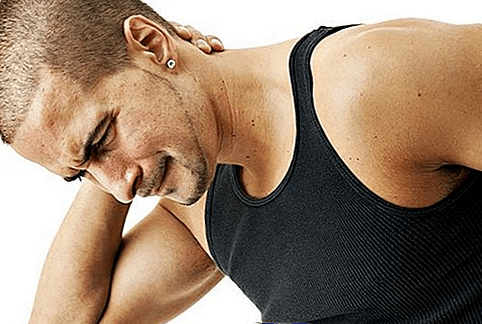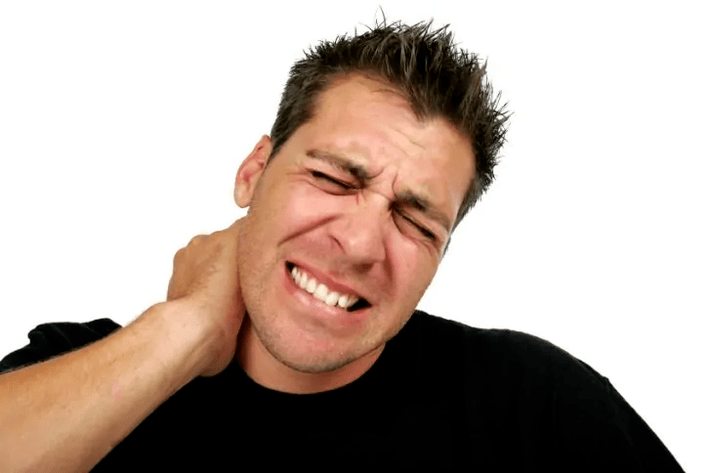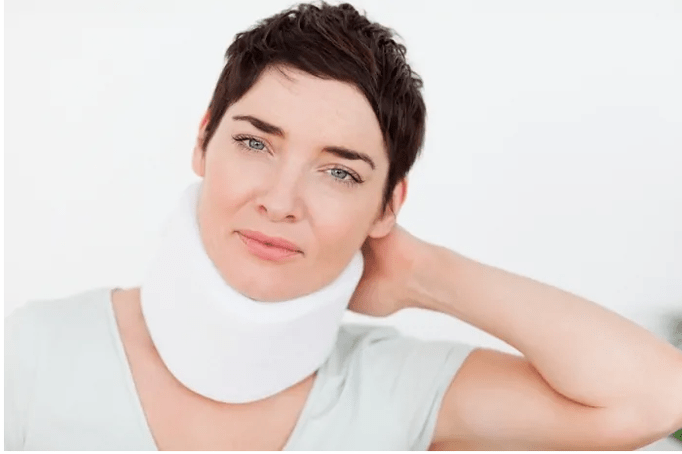Osteochondrosis is most often observed in the cervical spine, which is due to the anatomical features of the structures of this department. First, the cervical vertebrae are located very tightly to each other. And secondly, the muscle frame of the neck is poorly developed. It is for these reasons that the cervical vertebrae and the compression of the nerve roots, the blood vessels are so easy that the lower cervical vertebrae are more affected by the above.

Kimtomas of cervical osteochondrosis
The clinical symptoms of cervical osteochondrosis are extremely varied. Many people do not even suggest any symptoms (pain in their hands, dizziness, etc. ), can be associated with the pathology of the neck. In general, all the symptoms that appear with cervical osteochondrosis can be considered within three syndromes:
- Compression-brown syndromes;
- Irrite-Reflex syndromes;
- Vail Arttery Syndrome.
Compression syndromes
Against the background of cervical osteochondrosis, intervertebral hernias as well as osteophytes can form. These structures compress the roots of the nerves, leading to the onset of symptoms of radiculitis. The compression of each spine is associated with a specific reflex, motor, sensitive disorders:
- When compressing the spine of C1, pain occurs as well as impaired sensitivity (reduction of sensitivity, numbness, tingling of the skin, sensation of geese) in the parietal area;
- When compressing the spine of C2, pain develops as well as a change in sensitivity in the parietal and eliminating area of the head;
- When compressing the spine of C3, pain is noted as well as a change in sensitivity in the neck. In addition, a person can be disturbed by the feeling of swelling of the tongue on the one hand, difficult movements of the tongue and disturbance of speech.
- The spinal compression S4 is indicated by pain as well as a change in the sensitivity in the clavicle. Icote, dysphonia may occur. As the fibers of the diaphragmatic nerve pass into the spine, with compression of the spine, breathing can occur, pain in the heart.
- When compressing the spine of the C5, pain in the shoulder develops as well as a change in the sensitivity of the skin on the outer surface of the shoulder.
- When compressing a span of C6, the pain spreads from the neck to the shoulder, as well as the outer surface of the shoulder, the forearm and to the thumb of the brush. There is a violation of skin sensitivity in this area. The two -headed muscle is exaggerated, the reflex is reduced.
- When you compress the spine of the C7, the pain from the neck spreads under the shoulder blade, to the outer surface of the shoulder, forearm and II -II fingers. There is a violation of skin sensitivity in this area. The three -headed muscle is exaggerated, the reflex is reduced.
- When compressing the spine of C8, the pain from the neck spreads on the arm to the small finger. Skin sensitivity in this area is impaired. Hypotrophy and a decrease in the reflex from the three -headed muscle occurs.
For radicular syndrome, acute pain and its strengthening of the head are characteristic.
Irritation Syndromes-Reflex
The early stages of osteochondrosis are characterized by the appearance of reflex syndromes. In cervical osteochondrosis, the following options for reflex syndromes may occur:
- Cervicalgia is an intense sick neck pain that is expressed as much as possible after waking up in the morning, as well as when the head is rotated, coughing and even laughing.
- Cervicobrachialgia - The pain focuses on the neck and nape.
- Cervicobrachialgia - neck pain, shoulder and forearm.
Cervicobrahalgia can occur with muscle tonic, vegetative vascular and neurodystrophic manifestations. Muscle tonic syndromes are the result of reflex muscle spasm. The following muscle tonic syndromes differ:
- Lower sloping muscle syndrome - manifests itself through constant neck and back pain on one side, which is significantly increased during the turns of the head;
- The reflective shovel syndrome is considered with a sick neck pain and the upper corner of the scapula and the shoulder or even the lateral surface of the chest. A characteristic characteristic is an increase in pain during the projection of the brush open from the lower back.
Neurodystrophic syndromes include periatrosis packed by shoulder, epicondila shoulder, shoulder syndrome. Shoulder - Periarosis of the shoulder - characterized by pain in the shoulder joint, enhancing during the movements of the shoulder or lifting the arm up. The pain can radiate to the arm, the neck. The skin in the shoulder joint is swollen. For shoulder syndrome, the presence of signs of spatular periarthrosis in combination with vegetative-vascular, trophic changes in the wrist and brush joint is characteristic. The skin of the brush becomes edematous, its color changes, the local temperature increases. The epicondyls of the shoulder is a neurodystrophic change in the shoulder rod, at the site of attachment of many muscles. It is manifested by pain, constant pain in the rod, intensifying when applying sharp movements in the elbow or brush.

Vail Arttery Syndrome
The peak artery is performed in the channel formed by the processes of the cervical vertebrae. The vessel provides the blood supply to many brain structures. The narrowing of the vessel is possible both because of its reflex spasm and mechanical compression. When narrowing the vessel, spinal artery syndrome is formed, characterized by the following symptoms:
- Cranial: pain, constant headache, more often one, which is noticeable intensification with head movements. The pain spreads from the back of the forehead.
- Scalp soreness, determined by a slight touch, even with hair meetings.
- Disorders of kohleovestilarnyi: manifest by dizziness, tinnitus (ringing in the ears), reduction of light degree and disturbance of balance.
- Visual disorders: darkening, flickering flies in front of my eyes.
- Neurostenic syndrome: irritability, emotional lability, sleep disturbance.
- Vegetative symptoms: heat, chills, cooling of the hands.
- Fluctuations in blood pressure.
- With the compression of the spinal artery caused by a sharp turn of the head, one can lose consciousness. This option is also possible: a person falls as if primed, but at the same time he is conscious. Such a violation is called drop attacks.
Treatment of cervical osteochondrosis
It is very difficult to fight osteochondrosis in advanced shape. Various medicines are used to eliminate the symptoms of the disease. No less significant role is played by therapeutic gymnastics, as well as physiotherapy, massage. In some cases, wearing a special collar is very useful. Folk remedies will help to supplement the treatment.
Wearing a cervical collar
Wearing a collar helps to relieve muscle tension from the neck, and also gives the right position of the spine, thus eliminating compression of the spinal arteries and nerve roots. The cervical collars are hard (collar shantsa) as well as inflatable. The chance of the collar is a dense frame that is attached to the neck. He accepts all the weight of his head, thus relaxing the tense muscles of the neck. Inflatable collars are a device that must be placed on the neck, and then using a pear, pumping air. The drooping collar pulls the spine. The collar is not worn all day, but a few hours a day. The average length of wearing of the device is a month. Please note: The need to use the collar is determined by the doctor. In no case do you place it yourself without a prescription. In some cases, the collar can prevent vessels and nerves, which can have serious consequences.
Cervical osteochondrosis exercises

Therapeutic gymnastics is recommended for all patients with osteochondrosis in the absence of contraindications. The performance of exercise during the exacerbation of the disease is contraindicated. Therapeutic gymnastics can be done after the pain has disappeared. Regular efficiency of exercise allows you to strengthen the muscle frame as well as reduce the load on the intervertebral discs. Regular physical activity contributes to the improvement of the blood supply to the neck and as a result of the normalization of the metabolic processes occurring in the intervertebral discs. An approximate set of cervical osteochondrosis exercises:
- Sit in a chair. Rotate your head to the right and left.
- Tilt your head down, touching the attack of your chest.
- Pull your neck back while drawing a chin.
- Place your palm on your forehead and press it while it is important to tilt your head forward, resist.
- Palm should be applied alternatively to the temples and absolutely as in the previous exercise in order to place the resistance to the movement of the head with your hand.
- Lift your shoulders as much as possible, count to ten. Then lower your shoulders and relax. After ten seconds, do the same manipulation.
All exercises should be repeated ten times.

























